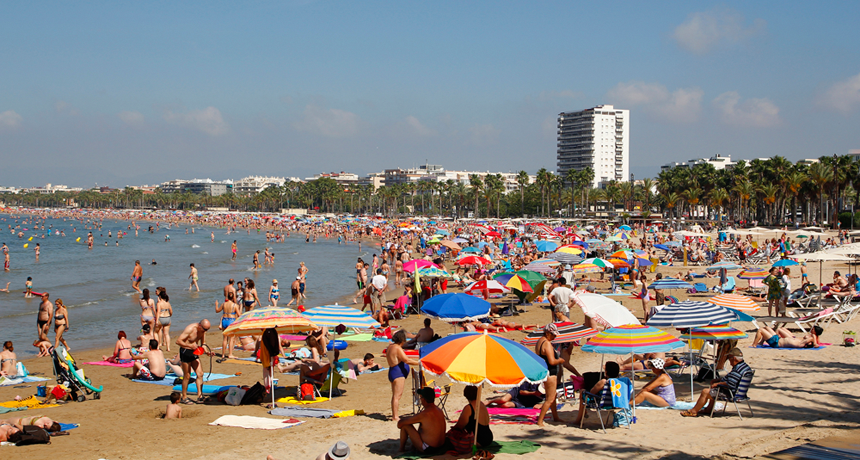Umbrella’s shade doesn’t prevent sunburn
Sunblock chemicals outperformed an umbrella’s shade in safeguarding skin from harmful rays

An umbrella would not be enough to stave off sunburn on this Spanish beach.
agafapaperiapunta/iStockphoto
By Lela Nargi
Thirteen-year-old Ada Cowan from Brooklyn, N.Y., would rather sit under an umbrella at the beach than put on sunblock. “I hate the sticky feeling of it on my skin,” she says. But is an umbrella’s shade enough to protect her skin from burning? Bad news for Cowan and anyone else who doesn’t like slathering on the gloopy stuff: A new study gives a definite edge to sunblock.
Hao Ouyang, who led the study, manages some research for Johnson & Johnson in Skillman, N.J. The company makes sunblock, including the type used in this study. His team wanted to see how two types of sun protection compare — umbrellas versus sunscreen.
For its tests, his team used a sunblock that had a sun protection factor — or SPF — of 100. Explains Hao, that means it had been designed to filter out 99 percent of the sun’s harmful ultraviolet (UV) rays. And in this comparison, umbrellas proved far less protective. More than three out of every four people (78 percent) shaded by a beach umbrella got sunburned. In contrast, only one in every four people who used the heavy duty sunblock got burned.
Hao’s team reported its findings online January 18 in JAMA Dermatology.

Educators and Parents, Sign Up for The Cheat Sheet
Weekly updates to help you use Science News Explores in the learning environment
Thank you for signing up!
There was a problem signing you up.
The skinny on the study’s details
When the sun’s UV rays hit skin, the body produces extra melanin. This is a pigment in the epidermis (Ep-ih-DUR-mis), the skin’s outmost layer. Some types of skin can make enough melanin to give them a protective suntan. Others cannot. When a lot of sunlight hits their skin, the deposited energy can cause a painful reddening or even blistering. Sunburn, or even a suntan, can increase the risk of skin cancer, according to the National Cancer Institute.
“We wanted to evaluate those people who can actually burn,” Hao notes. So his team chose participants who had skin that fell into types I, II and III on the Fitzpatrick scale. This scale classifies skin from I — a type that always burns and never tans — to VI. That last type never burns and always tans.
Forty-one people in the study had to sit in the shade of a typical beach umbrella. Another 40 people instead wore sunblock. All had to sit at the beach on a lake not far from Dallas, Texas, for a full 3.5 hours. They were sent out between 10 a.m. and 2 p.m. Notes Hao, that’s “the most dangerous time of the day” — when the sun’s UV rays are strongest.
The beach goers could not enter the water. And before they participated, the researchers checked everyone’s skin to make sure that none already had any sunburn.
Those weren’t the only rules. People getting the sunblock initially had to apply this lotion 15 minutes before going out to the beach. Then they had to reapply it at least once every two hours. Those in the shade-only group had to adjust their umbrellas as the sun moved across the sky so that they never ended up in direct sun. Everyone was allowed 30 minutes to either seek shade (if they were in the sunblock group) or leave it (if they were under the umbrellas).
Still, Hao admits that there were a lot of factors that complicated their findings. Even within their groups, neither those under the umbrellas nor those wearing sunblock responded identically. For instance, not everyone developed sunburns in the same place or at the same rates. That may be due to a variety of factors. For example, the researchers don’t know how well the sun-blockers applied the lotion, or even if they used enough and covered every last bit of exposed skin.
Indeed, “Most people don’t use enough sunscreen and do not apply it frequently enough to get the true, advertised SPF,” notes Nikki Tang. A dermatologist, she works at Johns Hopkins School of Medicine in Baltimore, Md.
And while umbrellas create shade, Hao points out that “UV rays reflect off the sand.” Those reflections are not something umbrellas can’t block. “Also,” he asks, “how much did the subjects move to sit in the center of the shade? And were they always covered fully?”
So although the study seemed simple, Hao notes that skin protection is “a complex issue.”
One thing is clear from the new results: Neither a beach umbrella nor sun block alone can prevent sunburn.
Concludes Tang, “The bottom line is that a combined approach to sun protection can only help.” Her advice: Use a nickel-size dollop of sunscreen — with an SPF of at least 30 — on your face. Use two to three tablespoons on the rest of your body. Apply the sunscreen every two hours, or sooner if you’ve gone swimming. Finally, cover up with hats and sunglasses and take advantage of any available shade.







